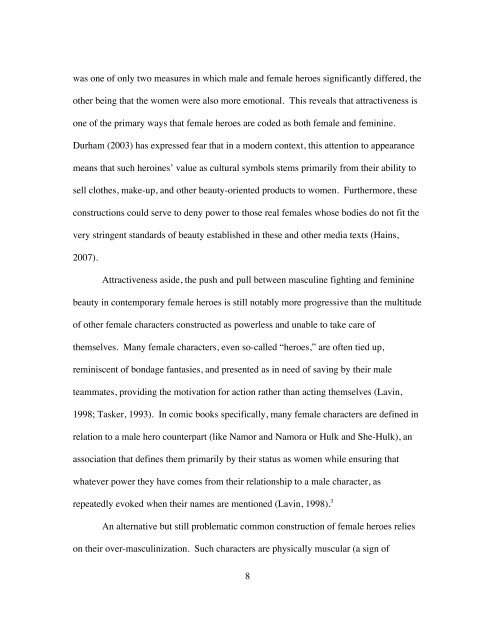Gender, Feminism, and Heroism in Joss Whedon and John ...
Gender, Feminism, and Heroism in Joss Whedon and John ...
Gender, Feminism, and Heroism in Joss Whedon and John ...
You also want an ePaper? Increase the reach of your titles
YUMPU automatically turns print PDFs into web optimized ePapers that Google loves.
was one of only two measures <strong>in</strong> which male <strong>and</strong> female heroes significantly differed, the<br />
other be<strong>in</strong>g that the women were also more emotional. This reveals that attractiveness is<br />
one of the primary ways that female heroes are coded as both female <strong>and</strong> fem<strong>in</strong><strong>in</strong>e.<br />
Durham (2003) has expressed fear that <strong>in</strong> a modern context, this attention to appearance<br />
means that such hero<strong>in</strong>es’ value as cultural symbols stems primarily from their ability to<br />
sell clothes, make-up, <strong>and</strong> other beauty-oriented products to women. Furthermore, these<br />
constructions could serve to deny power to those real females whose bodies do not fit the<br />
very str<strong>in</strong>gent st<strong>and</strong>ards of beauty established <strong>in</strong> these <strong>and</strong> other media texts (Ha<strong>in</strong>s,<br />
2007).<br />
Attractiveness aside, the push <strong>and</strong> pull between mascul<strong>in</strong>e fight<strong>in</strong>g <strong>and</strong> fem<strong>in</strong><strong>in</strong>e<br />
beauty <strong>in</strong> contemporary female heroes is still notably more progressive than the multitude<br />
of other female characters constructed as powerless <strong>and</strong> unable to take care of<br />
themselves. Many female characters, even so-called “heroes,” are often tied up,<br />
rem<strong>in</strong>iscent of bondage fantasies, <strong>and</strong> presented as <strong>in</strong> need of sav<strong>in</strong>g by their male<br />
teammates, provid<strong>in</strong>g the motivation for action rather than act<strong>in</strong>g themselves (Lav<strong>in</strong>,<br />
1998; Tasker, 1993). In comic books specifically, many female characters are def<strong>in</strong>ed <strong>in</strong><br />
relation to a male hero counterpart (like Namor <strong>and</strong> Namora or Hulk <strong>and</strong> She-Hulk), an<br />
association that def<strong>in</strong>es them primarily by their status as women while ensur<strong>in</strong>g that<br />
whatever power they have comes from their relationship to a male character, as<br />
repeatedly evoked when their names are mentioned (Lav<strong>in</strong>, 1998). 3<br />
An alternative but still problematic common construction of female heroes relies<br />
on their over-mascul<strong>in</strong>ization. Such characters are physically muscular (a sign of<br />
8

















